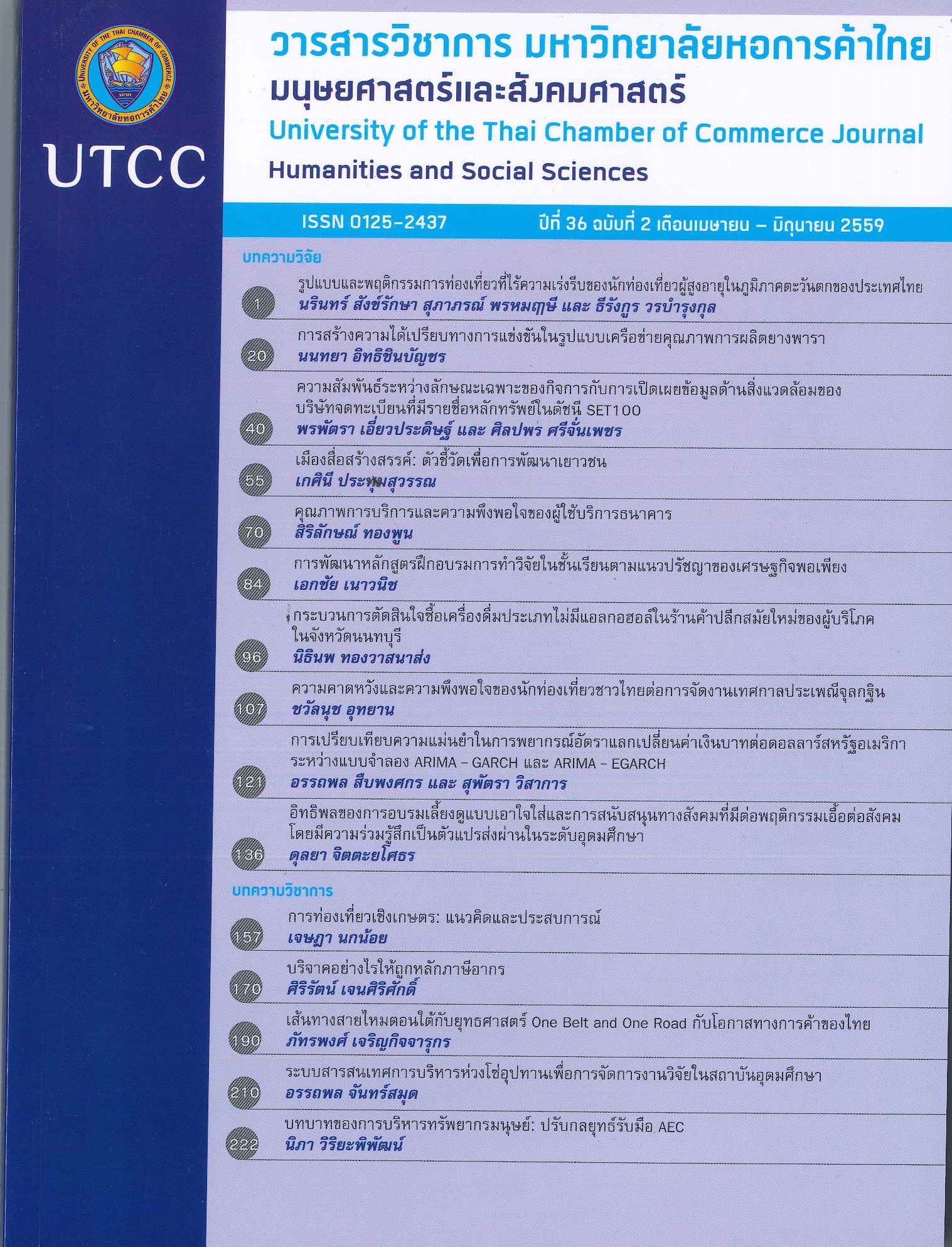Styles and Behavior in Slow Tourism for Senior Tourists in the Thai Western Region
Main Article Content
Abstract
This research aimed to 1) study behaviors, attitude, motivation and demand for slow tourism for senior tourists in the Thai western region, 2) analyze a the model of motivation in the slow tourism as mentioned above, and 3) propose guidelines for the management of slow tourism. Based on the methodology of action research, the research process was divided into three stages. Both Thai and foreign tourists, totally 400 persons were included in this study by using the accidental sampling technique. The research instruments were a general questionnaire, a questionnaire for endorsement of the model for motivation, guidelines for in-depth interviews and
focus group discussions. The collected data was quantitatively and qualitatively analyzed and presented through frequency, percentage, mean, standard deviation, t-test, F-test, LSD, Pearson's product-moment correlation coefficient and its content analysis, respectively. The results were as follows: regarding tourism behavior, the Thai and foreign tourists (43.50%) would seek and get the information data from internet sources, and 78.00% of them would aim to relax and tour for the trip. By and large they would travel with their friends (46.25%) and the time periods spent on one trip were longer than 5-7 days (75.73%). The number of trips in the four western Thai provinces was one time (44.80%). Most of them (86.25%) would stay with householders, or the so-called homestay tourism, and they would stay more than three days (67.00%), Nearly half of them (46%) would spend more than 5,000 Baht. Their overall attitude, satisfaction and motivation toward tourism were at the highest level. Furthermore, the model of tourism was produced and named the "1202T2A2 Model", and this was endorsed. Guidelines for slow tourism management were presented for 1) State Sector: the government offices should manage the tourism with quality approaches, arrange facilities for senior groups, develop quality in tourist services leading to an impressive and safe tourism, 2) Private Sector: the entrepreneurs should deal honestly in business and not exploit their customers, help to develop tourism and arrange tourist activities suitable for seniors groups, 3) Community and Local sector: should take care of the tourist sites, continuously support tourism, improve
basic infrastructure and facilities for the elderly,and develop new tourism sites.
Article Details
ลิขสิทธิ์ของบทความ
ผลงานที่ได้รับการตีพิมพ์ถือเป็นลิขสิทธิ์ของมหาวิทยาลัยหอการค้าไทย ห้ามมิให้นำเนื้อหา ทัศนะ หรือข้อคิดเห็นใด ๆ ของผลงานไปทำซ้ำ ดัดแปลง หรือเผยแพร่ ไม่ว่าทั้งหมดหรือบางส่วนโดยไม่ได้รับอนุญาตเป็นลายลักษณ์อักษรจากมหาวิทยาลัยหอการค้าไทยก่อน
References
Batra, A. 2009. “Senior Pleasure Tourists: Examination of their Demography, Travel Experience, and Travel Behavior Upon Visiting the Bangkok Metropolis.” International Journal of Hospitality & Tourism Administration 10,3 : 197-212.
Bovee, C. I. , Houston, Michael J., and Thill, J. V. 1995. Marketing 2nd e.d. New York : McGraw-Hill.
Goeldner, Charles R., and Ritchie,J. R. Brent. 2006. Tourism : Principles, Practice, Philosophies. 10th ed. Hoboken, NJ : Wiley.
Keeves, P. J. 1988. Educational Research, Methodology, and Measurement : An International Handbook. Oxford : Pergamon Press.
Lee, S. H., and Tideswell, C. 2005. “Understanding Attitudes towards Leisure Travel and the Constraints Faced by Senior Koreans.” Journal of Vacation Marketing 11,3 : 249-264.
Panompai, Prapapun,Tipsri, Vasana, and Chusee, Rachean 2006 The Report Attitude of Foreign Tourist towards Reception of Chiang Rai. Bangkok : Thailand Research Fund.
ประภาพร พนมไพร, วาสนา ทิพย์ศรี และราเชนทร์ ชูศรี. 2549. รายงานการวิจัย ทัศนคติของนักท่องเที่ยวชาวต่างประทศที่มีต่อการต้อนรับของชาวเชียงราย. กรุงเทพมหานคร : สำนักงานกองทุนสนับสนุนการวิจัย.
Srisomyong, Nion. 2009 “A Survey of Foreign Tourists Attitude towards Decision to Travel in the Provinces Struck by Tsunami in Thailand.” Master’s Thesis, University of the Thai Chamber of Commerce.
นิออน ศรีสมยง. 2552 “การสำรวจทัศนคติของนักท่องเที่ยวชาวต่างชาติต่อการตัดสินใจไปท่องเที่ยวในจังหวัดภาคใต้ที่ประสบภัยพิบัติคลื่นยักษ์สึนานิ” วิทยานิพนธ์ปรัชญามหาบัณฑิต คณะบริหารธุรกิจ มหาวิทยาลัยหอการค้าไทย.
Sungrugsa, Narin,Rattanapongpinyo, Thaninrat and Pawongsa, Phakamas. 2015 “The Competency in Marketing Competitive Advantage of Stakeholders Development Model Related to Cultural Tourism along the Ways of Creative Economy among Four Dvaravati Provinces to Support ASEAN.” University of the Thai Chamber of Commerce 35, 1 : 22-38. (in Thai).
นรินทร์ สังข์รักษา, ธนินท์รัฐ รัตนพงศ์ภิญโญ และผกามาศ พะวงษ์. 2558 “การพัฒนารูปแบบขีดความสามารถในการแข่งขันทางการตลาดของผู้เกี่ยวข้องกับการท่องเที่ยวเชิงวัฒนธรรมตามแนวทางเศรษฐกิจสร้างสรรค์ในกลุ่มทวารวดี 4 จังหวัดเพื่อรองรับประชาคม อาเซียน.” วารสารวิชาการ มหาวิทยาลัยหอการค้าไทย 35, 1 : 22-38.
Thaisom Rungtip, Charoenkijjarukon Pataapong, and Raksakaew, Achira. 2012 “Promoting Community Based Tourism Management for Sustainable.” University of the Thai Chamber of Commerce 32, 2 : 27-48.(in Thai).
รุ่งทิพย์ ไทยสม, ภัทรพงศ์ เจริญกิจจารุกร และอชิรา รักษาแก้ว. 2555. “การส่งเสริมศักยภาพด้านการท่องเที่ยวเชิงอนุรักษ์ของภาคกลางตอนล่างเพื่อนำไปสู่การพัฒนาที่ยั่งยืน.” วารสารวิชาการ มหาวิทยาลัยหอการค้าไทย 32, 2 : 27-48.

